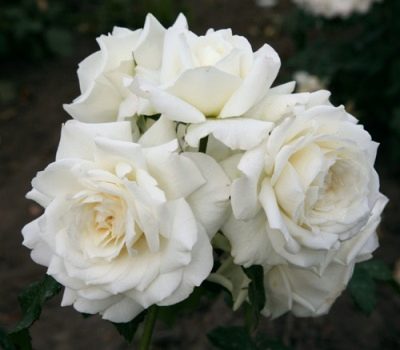
- Name synonyms: Alaska, Rosa Alaska
- Group: climbing
- The main color of the flower: white
- Flower shape: cupped
- Flower size: large
- Diameter, cm: 6-8
- Flower type by number of petals: terry
- Scent: pleasant, fruity, with hints of citrus
- Description of the bush: vigorous, dense
- Bush height, cm: 200-220
A beautiful flower bed, a glade in the garden of roses grown with your own hands, an arch decorated with flowers or a veranda in the country always cheers you up. To do this, it is enough to choose a non-capricious rose variety that does not require complex agricultural technology, quickly adapts to climatic characteristics, and also blooms for a long period. These include the picturesque rose of Alaska.
Breeding history of the variety
Climbing Rose Alaska is a beautiful representative of the German selection, bred in 2005. The authorship belongs to Tim Herman Cordes. Rose Alaska was obtained by crossing Moonlight with a seedling. It is possible to grow a flower shrub in different climatic zones, but it behaves differently - in the southern part, as well as in the Central region, it grows larger, abundantly flowering. In addition, the climbing shrub is grown in Ukraine.
Description of the variety
Alaska is a powerful shrub that grows up to 200-220 cm in height. The plant is characterized by moderate thickening of large dark green leaves with a pronounced gloss, strong and flexible shoots, well amenable to laying on supports, as well as a developed root system. It is characteristic that there are few thorns on the stems. A distinctive feature is the rapid growth rate of the plant, so rose bushes often reach a diameter of 100-110 cm.
Advantages and disadvantages
Each plant has its own pros and cons. Among the advantages, it is worth highlighting the continuity of flowering, high frost resistance, heat tolerance when the roses do not fade, good immunity, resistance to prolonged rains, in which the foliage does not turn brown.
The shrub has very few disadvantages. The most significant is the low intensity of the aroma.
Flowering features
The flower represents a class of re-flowering species. The bush has abundant flowering. The beautiful bushes covered with flowers stand for a long period - from June to November. The flowers of the rose are collected in inflorescences of 3-5 pieces. It is characterized by a white-greenish goblet bud, from which a large double rose, consisting of 40-50 petals, blossoms. The diameter of the flower reaches 6-8 cm. The color of the rose is non-standard - white-cream with pinkish or yellowish edges. Pink and creamy shades appear in the flower in conditions of increased dampness and humidity. The blossoming flowers give off a light, fruity aroma with citrus notes.
Use in landscape design
Rose Alaska is a very picturesque plant that will harmoniously fit into any floral ensemble. The shrub can decorate a column, arch, gazebo, and also complement any festive composition. In addition, the shrub of creamy-snow-white roses is suitable for single plantings, as well as for dense hedges, zoning flower fields.
Landing
A climbing rose is planted since April, when the temperature regime has already stabilized. In the southern regions, autumn planting is allowed, but in a very short time. For landing, a sunny place is chosen, protected from drafts and gusty winds.It is also worth noting that the shrub grows well and blooms in partial shade.
Shrub grows comfortably in light, fertile, breathable and moist soils with good drainage system. It is important that the acidity of the soil is lowered or neutral. It is not recommended to plant in lowlands, in places with swampy soil, as well as in the northern side of the garden. The occurrence of groundwater must be deep - at least 1.5-2 meters.
Growing and care
A flower shrub is cultivated by means of seedlings, the rhizomes of which are pre-treated with growth stimulants. For the plant, a hole 50-60 cm deep is prepared in advance, where a drainage layer (10 cm thick) of crushed stone or gravel, a layer of fertilizers and an earth ball, about 8-10 cm thick, are laid. The plant is planted at an inclination of 30 degrees, fixing it to the support. At the end of the procedure, abundant watering with warm water under the root is performed, and then a layer of peat mulch is laid.
Caring for a flower shrub consists of standard procedures: watering, weeding, loosening, fertilizing, sanitary pruning, and disease prevention. In addition, the removal of wilted flowers is mandatory.
Watering and feeding
Water the roses with settled or warm water at the rate of 15-20 liters under one bush. In dry summers, watering is carried out twice a week. Watering is completely stopped at the end of August. Alaska roses are fed seasonally - nitrogen-containing complexes are introduced in the spring, and phosphorus-potassium fertilizers in the summer.
Pruning
Pruning is carried out 2-3 times per season. In early spring, remove all frozen shoots, and also shorten the tops. In the summertime, dried buds and branches are removed. In the autumn, sanitary pruning is carried out, in which damaged and diseased shoots are removed, and the shrub is thinned out.
Frost resistance and preparation for winter
Despite the good frost resistance, before the onset of winter, after sanitary pruning of the shoots, a cover with agrofibre or a thick layer of spruce spruce mulch is performed. In early spring, the shelter is removed. It is these measures that will help the plant to comfortably survive the cold and little snowy winter, especially in the northern part of the country.
Diseases and pests
The plant is characterized by strong immunity, therefore it is rarely affected by fungal diseases. It is extremely rare that Alaska rose bushes can attack spider mites, aphids and leafworms.































































